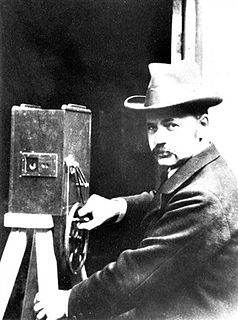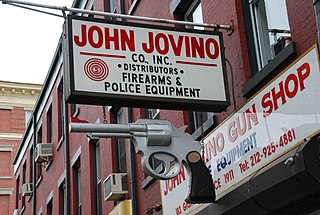Related Research Articles

The Birmingham Small Arms Company Limited (BSA) was a major British industrial combine, a group of businesses manufacturing military and sporting firearms; bicycles; motorcycles; cars; buses and bodies; steel; iron castings; hand, power, and machine tools; coal cleaning and handling plants; sintered metals; and hard chrome process.

Robbins is a city in Moore County, North Carolina, United States. The population was 1,097 at the 2010 census.

The Ross rifle is a straight-pull bolt action rifle chambered in .303 British that was produced in Canada from 1903 until 1918.

The Gewehr 41, commonly known as the G41(W) or G41(M), denoting the manufacturer, is a battle rifle manufactured and used by Nazi Germany during World War II. It was largely superseded by the Gewehr 43, which incorporated a more reliable method of operation.
Savage Arms is an American gunmaker based in Westfield, Massachusetts, with operations in Canada. Savage makes a variety of rimfire and centerfire rifles, as well as Stevens single-shot rifles and shotguns. The company is best known for the Model 99 lever-action rifle, no longer in production, and the .300 Savage. Savage was a subsidiary of Vista Outdoor until 2019 when it was spun off.
INSASor Indian Small Arms System is a family of infantry arms consisting of an assault rifle and a light machine gun (LMG). It was designed by the Armament Research and Development Establishment and manufactured by the Ordnance Factories Board at its various factories. The INSAS assault rifle was the standard infantry weapon of the Indian Armed Forces for almost three decades.

Daisy Outdoor Products is an American airgun manufacturer known particularly for their lines of BB guns. It was formed in 1882 initially as the Plymouth Iron Windmill Company in Plymouth, Michigan, to manufacture steel windmills, and from 1888 started bundling BB-caliber air guns with each windmill purchase as a sales promotion. With the unrivaled popularity of their 1888-model Daisy BB Guns, the company changed the name to Daisy Manufacturing Company in 1895 and switched their business to solely producing air guns for sale. Throughout the 20th century, Daisy has been known as a company that makes and sells BB guns and pellet youth rifles. Their Red Ryder BB Gun is perhaps the best known and longest production item, which has been featured in many TV shows and movies since its introduction in the spring of 1940.

James Purdey & Sons, or simply Purdey, is a British gunmaker based in London, specialising in high-end bespoke sporting shotguns and rifles. Purdey holds three Royal Warrants of appointment as gun and rifle makers to the British and other European royal families.
Westley Richards is a British manufacturer of guns and rifles and also a well established gunsmith. The company was founded in 1812 by William Westley Richards, who was responsible for the early innovation of many rifles used in wars featuring the British Army during the 1800s. It remained in the hands of the Richards family until it was purchased by Walter Clode in 1957. Currently the company has two listed directors, Alexander Clode and Sheikh Sultan Bin Jassim Al Thani of Qatar. The company has received a number of royal warrants since 1840.

The American Precision Museum is located in the renovated 1846 Robbins & Lawrence factory on South Main Street in Windsor, Vermont. The building is said to be the first U.S. factory at which precision interchangeable parts were made, giving birth to the precision machine tool industry. In recognition of this history, the building was declared a National Historic Landmark in 1966. In 1987, the building was recognized by the American Society of Mechanical Engineers as an International Heritage Site, and the collection was recognized as an International Heritage Collection. For each of these designations, the armory was considered a site where pivotal events occurred in the history of American industry, as well as a place that lends itself to comprehensive interpretation of that history.

James A. Williamson was a Scottish photographer and a key member of the loose association of early film pioneers dubbed the Brighton School by French film historian Georges Sadoul. He is best known for The Big Swallow (1901), a trick film with innovative use of extreme close-up, as well as Fire! and Stop Thief!, dramas with continuity established across multiple shots.

Two 19th century factory buildings are sited on a bank beside Starr Mill pond on Beverly Heights just off Middlefield Street. Each building is 3½ stories tall, and overlooks a picturesque pond and woods to the west; a parking lot packed with trucks and industrial equipment on the south; and nineteenth century housing on Beverly Heights to the north.

The Hawken rifle is a muzzle-loading rifle that was widely used on the prairies and in the Rocky Mountains of the United States during the early frontier days. Developed in the 1820s, it became synonymous with the "plains rifle", the buffalo gun, and the fur trapper's gun. It was displaced after the Civil War by breechloaders and lever-action rifles.

John Jovino Gun Shop or the John Jovino Company was a firearms dealer and factory located at 183 Grand Street, in Little Italy, a neighborhood of the New York City borough of Manhattan. It was the oldest gun retailer in New York City and said to be the oldest gun shop in the United States. The store closed as a result of the financial hardships from the COVID-19 pandemic.

Joseph Williamson was an eccentric English businessman, philanthropist and property owner who is best known for the Williamson Tunnels, which were constructed under his direction in the Edge Hill area of Liverpool, England. His philanthropy earned him the nickname the King of Edge Hill, whilst his tunnel-building activity earned him posthumous nicknames, including the Mole of Edge Hill and the Mad Mole.

The WKW Tor or Wilk (Wolf) is a modern anti-materiel and/or sniper rifle produced in Poland by the Zakłady Mechaniczne Tarnów factory. The nickname "WKW Tor" stands for Wielkokalibrowy Karabin Wyborowy or Large Caliber Sniper Rifle. Its military designation in the Polish army is known as the Tor. This rifle was developed between 2000 and 2004 and the first selected units in the Polish army apparently received Wilk/Tor rifles in around 2005 onwards.

Arthur William Savage, was a businessman, inventor, and explorer. He is most famous for inventing the Savage Model 99 lever-action rifle, which remained in production for over 100 years, and founding Savage Arms. However, his most lasting and valuable inventions may be radial tires, and it has been argued, the modern detachable box magazine used in almost all modern military firearms. He also invented an early torpedo and built and raced cars.

Martha Matilda Harper was an American businesswoman, entrepreneur, and inventor who launched modern retail franchising and then built an international network of 500 franchised hair salons that emphasized healthy hair care. Born in Canada, Harper was sent away by her father when she was seven to work as a domestic servant. She worked in that profession for 25 years before she saved enough money to start working full-time producing a hair tonic she invented. The product, and the creation of special hair salons that utilized it, was successful. Harper began franchising the salon model to low-income women, and by its peak the company included more than 500 franchises and an entire line of hair care products.
Jacket is an unincorporated community in the southeastern corner of McDonald County, Missouri, United States. It is located on Missouri Route KK, approximately one-half mile north of the Missouri-Arkansas border and one mile west of the McDonald and Barry county border. The community is on the east bank of Big Sugar Creek.
Vincenzo Bernardelli S.p.A. is an now-defunct Italian firearms manufacturing company, founded in 1721 by Vincenzo Bernardelli.